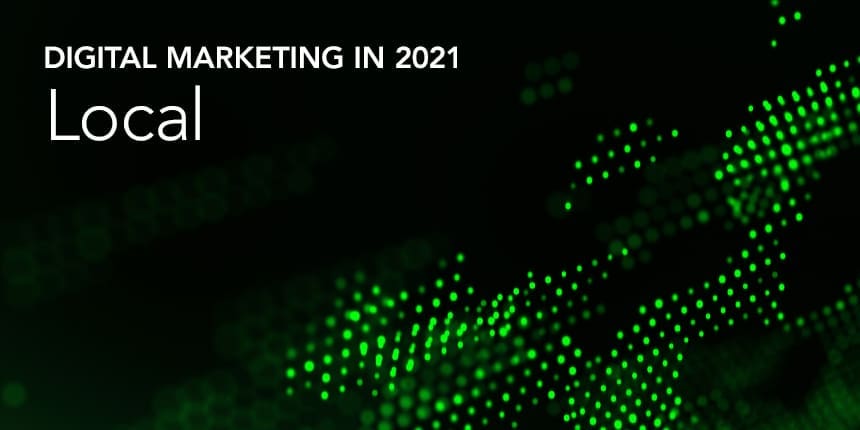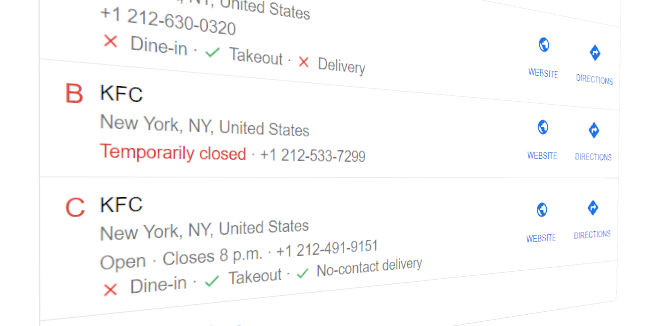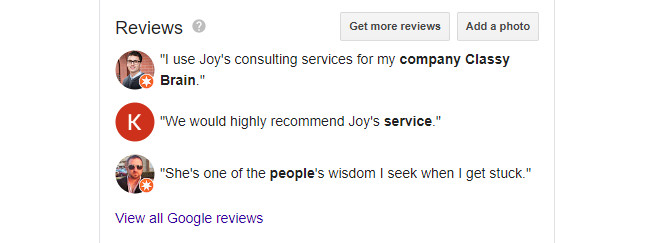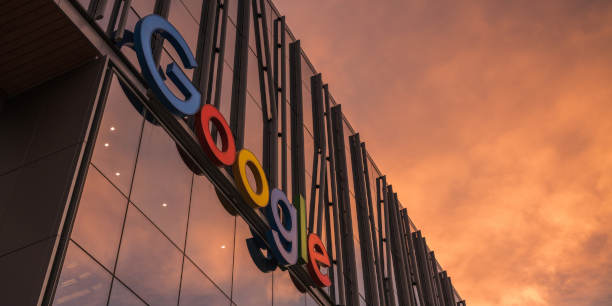
Maximize your local presence through strategic location management.

You don’t need us to tell you that the year 2020 will go down as one of the most disruptive on record. Yet, despite the disruption and disorder, there was significant progress made in a huge number of fields, disciplines, and industries—and particularly in digital marketing.
Brands the world over have been forced to accelerate their digitization, bringing forward digital roadmaps by several years. But our subject matter experts have been anticipating these developments all along. For them, 2021 is now in clearer focus because of the chaos of the last year, not despite it.
In the first installment of our seven-part predictions series (all of which are available right now if you just can’t wait), we reveal how local listings will assume an even more significant role in customer journeys over the next 12 months and more.
Attributes and amenity information once only existed within the hospitality vertical in Google My Business (GMB), but the pandemic saw Google attributes become a minimum requirement for GMB listings to function properly. Starting with restaurants needing to make it abundantly clear if they offered takeout and delivery, attributes expanded throughout 2020 to cover a multitude of business offerings in every business category.
Every business worth its salt now includes attributes on their business listings to inform users about fundamental business aspects, such as online or in-person services. Others have taken it a step further and have provided auxiliary information about their business, such as wheelchair accessibility, dietary options, and female or veteran leadership and ownership.

In other words, attributes have become commonplace either as a requisite for a listing’s completeness or as additional content to further improve user experiences. With their prominent position on a business’s listings and knowledge panel, users now expect to see attributes. Listings that still haven’t adopted them look neglected next to their competitors.
In 2021, incomplete listings will have attributes assigned to them via crowdsourced data. Google can already populate addresses, phone numbers, and websites without any verification from the business owner, and attributes are next on the list.
Attributes have shown themselves to be a useful, practical feature, and Google will force their use when business owners fail to implement them. Critically, attributes will become a major factor in local SEO—matching a business with a user’s query—so all business owners will need to include attributes on their listings to remain competitive. Just remember that automatic assignment of attributes will inevitably lead to some undesirable inaccuracies; your best bet is to manage them directly.
From adding a review carousel to a new “Get more reviews” button on the local knowledge panel, Google strongly emphasized its reviews in 2020. In previous years, the search giant was happy for users to rate businesses on a basic five-star scale, but now heavily emphasizes review content. Why? Because users can now search a business’s reviews by key terms and, more importantly, Google results now include review content when matching searches to businesses.

Google is attempting to increase its market share in the review space and, more specifically, is trying to poach users from sites like Yelp and Trip Advisor. That’s why it’s copying many of Yelp’s more robust review features to encourage the kind of reliable, content-rich reviews users prefer (which it can mine to auto-assign attributes, as explained above). Google is even now suggesting that users follow “local guides”, who have in turn been encouraged to leave more reviews of their own.
By increasing the quality and scope of their reviews, Google is hoping that users will look at more than just the star rating of businesses—and come to see Google as the de facto source of reliable information for users in the consideration stage.
Subscribe to our monthly newsletter.
Google is in the process of migrating information to knowledge graphs and GMB listings. Users will no longer need to click through from the SERP to find the information they need. As a result, traffic to brand’s websites and local pages may shrink as users increasingly find decision-critical information in search results.
But Google isn’t content to simply provide more information upfront. Users can call almost any local business directly from the SERP, and in some cases can even reserve a table through Google. We can easily see Google doubling down and adding even more conversion functionality, such as appointment bookings for all types of businesses or “buy it now” for product searches.
The purpose of all these improvements—displaying more information, adding higher quality reviews, and adding additional conversion points—is to keep users on Google above all other websites. By providing more value (mostly by poaching the value that other websites offer), Google becomes the primary platform in all parts of a consumer journey from discovery, to research, to purchase. This consolidation will have an Amazon-like effect, where businesses effectively abandon their own first-party platforms to better serve users where they congregate. With Google controlling the user journey, businesses will need to bend the knee and possibly sacrifice a percentage of revenue to Google’s platform for every lead it generates, even via historically organic results.

It is not just a matter of more ads placed on the top of Google search results: it’s a matter of Google offering a better organic experience for users—but requiring businesses to pay to be part of that organic experience. For instance, in 2020 Google allowed businesses to make Google Posts at scale for no cost, ostensibly for important COVID-related updates. But the search giant also stated that it was a temporary measure. Don’t be surprised if Google Posts become a paid feature once they’re an accepted (and even expected) part of the user experience.
Don’t think they would? We’ve seen it already in the hospitality sector. Google denies hospitality businesses the normal tools they provide to every industry: hospitality brands are unable to use Google Posts or link to an appointment/booking URL in their knowledge panel. Moreover, hotel knowledge panels are driven by an ad system wherein hotel owners must bid via a room rate commission fee called “Google Hotel Ads” instead of bidding on a keyword in the conventional sense. That’s right—hotels need to bid in their own knowledge panels!
Brands in the future will need to fight to stay on top of Google’s organic listings as Google poaches the leads formerly converted on the brand’s own website. Businesses need to find a way to compete with Google and generate leads themselves or otherwise play ball with the search engine and go the way of the hospitality industry, paying for organic features just to remain competitive.
Local listings and their related features are already an integral part of the customer journey, and 2021 will see them further embedded into our online behavior. The challenge for businesses especially those with distributed footprints will be to continually manage and optimize every new feature for every location, encourage authentic (and long-form) reviews, and know just how much to engage in Google’s forthcoming pay-to-win dynamic.
But what will the next 12 months look like in media, content, SEO, and other critical digital disciplines? Stay tuned for the next installment or download the entire series right now in one handy PDF.
Maximize your local presence through strategic location management.
Maximize your local presence through strategic location management.
Subscribe to our monthly newsletter.